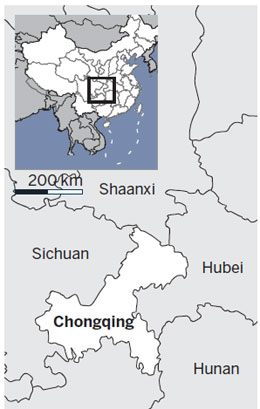Finnair's shortcut to success
Updated: 2012-06-01 09:12
By Alexis Hooi (China Daily)
|
||||||||
|
Finnair's Mika Vehvilainen sees growth potential in both business and leisure travel between Chongqing and Europe. Xu Wei / China Daily |

Airline debuts first direct link from Europe to Chinese megacity
In the scramble among airlines to tap an increasingly lucrative market in the East, a European carrier has already found one of the "shortest" routes possible deep into Southwest China.
Earlier last month, Finnair opened a flight between Helsinki and Chongqing, becoming the first airline to directly link Europe with the Chinese megacity. The flight will take a mere 8.5 hours, four times a week.
Finnair President and CEO Mika Vehvilainen says the move is part of a strategy that is "highly focused on Asia".
"The reason is simple: the geographical location of Helsinki is such that it is the shortcut between Europe and Asia. That's the shortest way to travel between the two areas," he says. "Finnair has been on an expansion in Asia since early 2000. More than half of our revenue today already comes from Asia, and we plan to double our revenue from Asia by 2020."
The Finnish carrier chose Chongqing as a platform to help achieve those targets after the megacity "came out tops" during evaluations two years ago to find suitable destinations, Vehvilainen says.
"The decision was based on the size of the market, the location, its competitiveness, the growth prospects and many other factors. What also appeals to us in Chongqing is the fact that it's a growing city, one of the largest cities in the world, and we see that there are large and expanding industries here, especially in manufacturing," he says. "We also see Chongqing-based businesses having potential in Europe, hence business travel out of Chongqing expanding into Europe."
Chongqing is one of four Chinese province-level municipalities - the others being Beijing, Shanghai and Tianjin - and the only one inland, away from the traditionally richer coastal cities. Its urban population, numbering more than 32 million, is expected to double in the next five years as one of the world's fastest-growing cities.
Major industries, including automotive, electronics and chemical companies from home and abroad, are already expanding their presence in Chongqing, fueling high expectations of business travel and cargo flow. The city's airport has opened more than 100 routes to more than 80 Chinese and Asian cities, and airport authorities are planning to receive more than 40 million passengers a year.
"We see a lot of European business travel into Chongqing because inland China, western China, is expanding at the moment. It's getting a lot of support from the government and it's getting more and more interesting for European businesses," says Vehvilainen, whose airline also flies to three other Chinese cities - Beijing, Shanghai and Hong Kong.
"We doubled our corporate sales out of Asia from 2009 to 2010. And we grew more than 50 percent last year from 2010 as well. We enjoy very strong growth and that is of course driven, especially in China, by the fast globalization and expansion of Chinese businesses."
Leisure travelers also form a major part of Finnair's expansion plans via Chongqing, he says.
"When we look at leisure travel, the number of Chinese outbound tourists is already exceeding that of inbound tourists. The number of Chinese tourists out of China is expanding at 20 percent a year. The growing Chinese wealth and growing Chinese middle class are driving this growth, and we see huge potential for Chinese outbound tourists into Europe," Vehvilainen says.
"Whatever happens with the European fiscal crisis, Europe will always be a great destination. We are already seeing very strong demand out of Chongqing for European leisure travel.
"The other way around, the number of European tourists coming into Chongqing is also fairly strong. There are many attractions here."
Finnair's policy of expansion and growth in western China is also being carried out with "very good support" from the Chongqing authorities, Vehvilainen adds.
"That comes both in terms of enabling us to operationally open the route and in terms of financial support in the initial phases. Generally, in opening a new route, investments are needed, and that can be unprofitable in the beginning. Typically, airport authorities or local authorities incentivize the opening of such routes," he says.
"But it's a short-term incentive and obviously we take the view that once we open the route it has to be profitable in the long term."
While the Finnair CEO cites challenges, such as rapidly rising fuel costs and the economic crisis in Europe, he has no doubt that the carrier's new route will deliver.
"Also in Chongqing, the good news is that there is very little competition. And that is also the bad news, in the sense that you have to make people realize there is now an opportunity to travel from here to Europe very conveniently, and to Europeans that you can now fly to Chongqing directly," Vehvilainen says.
"But our product is overwhelmingly better than anyone else's. We offer the fastest connections. We fly now to 11 destinations in Asia and out of those 11 destinations we offer more than 50 destinations in Europe. And out of those 50 destinations, in more than 70 percent of the cases, we generally offer the fastest travel time and, of course, for business travelers, time is money."
alexishooi@chinadaily.com.cn
(China Daily 06/01/2012 page11)

 Relief reaches isolated village
Relief reaches isolated village
 Rainfall poses new threats to quake-hit region
Rainfall poses new threats to quake-hit region
 Funerals begin for Boston bombing victims
Funerals begin for Boston bombing victims
 Quake takeaway from China's Air Force
Quake takeaway from China's Air Force
 Obama celebrates young inventors at science fair
Obama celebrates young inventors at science fair
 Earth Day marked around the world
Earth Day marked around the world
 Volunteer team helping students find sense of normalcy
Volunteer team helping students find sense of normalcy
 Ethnic groups quick to join rescue efforts
Ethnic groups quick to join rescue efforts
Most Viewed
Editor's Picks

|

|

|

|

|

|
Today's Top News
Chinese fleet drives out Japan's boats from Diaoyu
Health new priority for quake zone
Inspired by Guan, more Chinese pick up golf
Russia criticizes US reports on human rights
China, ROK criticize visits to shrine
Sino-US shared interests emphasized
China 'aims to share its dream with world'
Chinese president appoints 5 new ambassadors
US Weekly

|

|








